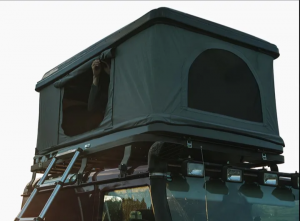News Center+ 查看更多
News Center
+ 查看更多
A super-detailed guide to the types, materials, pros and cons, and use of outdoor camping tents+ 查看更多
A super-detailed guide to the types, materials, pros and cons, and use of outdoor camping tents
+ 查看更多
Date:2023-10-19
Outdoor camping activities, tents are essential tools, providing wind, rain, warmth, rest and other functions. But there are many kinds of outdoor tents, each kind of outdoor tent has its use scene and characteristics, we will also encounter a variety of professional terms when selecting. According to my outdoor experience for many years, I have made a detailed analysis of the selection and use of tents at 10 key points, hoping to be useful to everyone.
Types of outdoor tents
According to the appearance, outdoor camping tents can be divided into many kinds, as shown in the following table: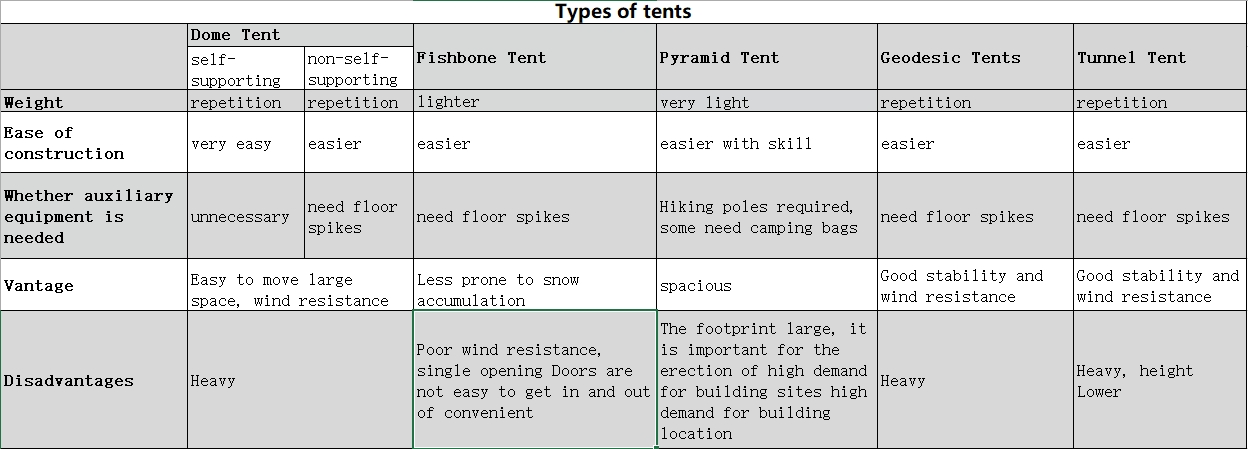
Outdoor tents with different appearances are suitable for different occasions:
- Park, suburban camping: yurt tent or fish ridge tent This scene is generally self-driving, we carry the tent generally not too far away or direct car can drive to the campsite, so self-weight is not the primary factor, on the contrary, yurt tent space is large, the advantages of double doors are very suitable for families, children to play; Therefore, it is more recommended to tent, but also can choose quick-opening tent.

- Hiking camping around the city: pyramid tents, fish ridge tents, tunnel tents
This scene is often hiking camping, you need to carry your own tent, so the pyramid tent with lighter weight is the first choice, with the use of alpenstock scene is also more abundant, in addition to the pyramid tent interior is relatively high, support up is also very cool said. Fish ridge tents have good wind resistance and are suitable for camping in valleys or by the sea.

- Snow mountain, plateau hiking camping: fish ridge tents, tunnel tents or geodesic tents are mainly used by outdoor enthusiasts at high altitudes and low temperatures, requiring strong wind and cold resistance.
Automatic quick-open tent and manual tent selection
Many e-commerce platforms recommend automatic quick-open tents also called self-supporting tents, placed on the ground can automatically open the kind, save the trouble of their own poles, attractive to novices, mainly for outdoor leisure occasions.
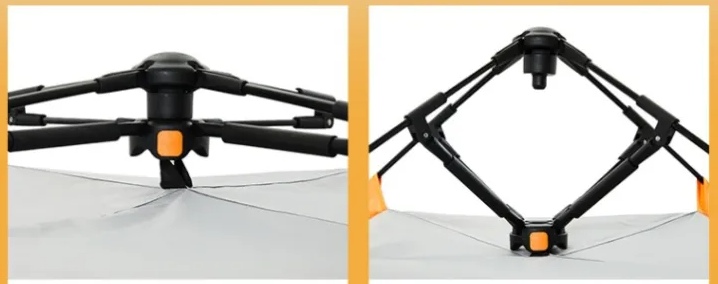
- What scene to choose quick-open tent quick-open tent is relatively heavy, self-driving is a mandatory option, and putting in the camper also nothing. Picnics and camping in general parks, the weather is also relatively good, there will be no strong wind, or rain. Normal overnight stays are fine, but bad weather may not be appropriate.
- The advantage of quick-opening tents is that they are easy to open, easy to move, and easy to close. Generally, they are quite cheap.
- The disadvantage of quick-opening tents are not suitable for outdoor hiking occasions. Quick-opening tents are heavier than tents that usually need to be built by hand, adding an extra burden to backpackers. It is also not suitable for windy occasions. The quick-opening tent itself requires more support structures, but the materials are very thin. When the wind blows, it will be damaged. The ground nails are also small and cannot be fixed. Quick-opening tents are generally not waterproof, so they are not suitable for use in rainy days. In addition, quick-opening tents are more easily damaged.
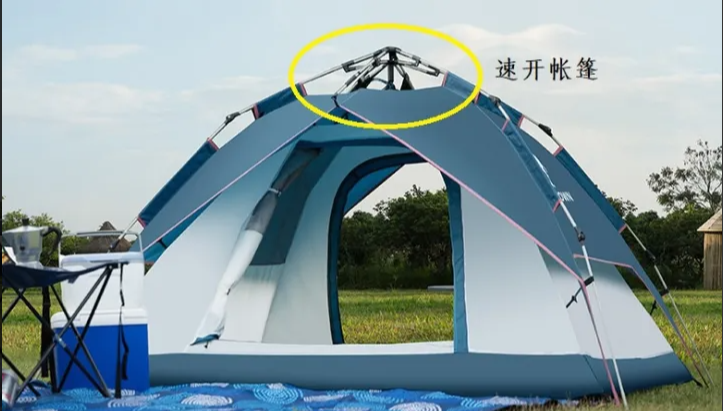
Therefore, if you are planning to play outdoors for a long time, then don't consider quick-opening tents.
How to choose three seasons tents and four seasons tents
The three-season tent is mainly aimed at the three seasons of spring, summer and autumn. It is also a popular style at present. It can basically meet the needs of ordinary camping enthusiasts. The product lines of major brands are also quite rich, and the market share is relatively high.Four seasons tents take into account all seasons, pay more attention to windproof design, have certain thermal insulation performance, lighter weight than alpine tents, more convenient to carry, but because the pursuit of stability will sacrifice some permeability and space, suitable for high altitude or winter outdoor environment, many camping enthusiasts mostly choose this type of tent.
Camping is not a picnic. There are different scenery all year round. Although it is cold outdoors in winter, with the continuous enrichment of heating equipment products such as firewood stoves and kerosene stoves, prices continue to drop. Winter outdoors is more interesting than other seasons, and winter outdoors is not infested by snakes and insects, which is relatively safer and less troublesome. So on a reasonable budget, consider a four-season tent.
Waterproof outdoor tents
- The waterproof property of outdoor tents mainly depends on the waterproof index:
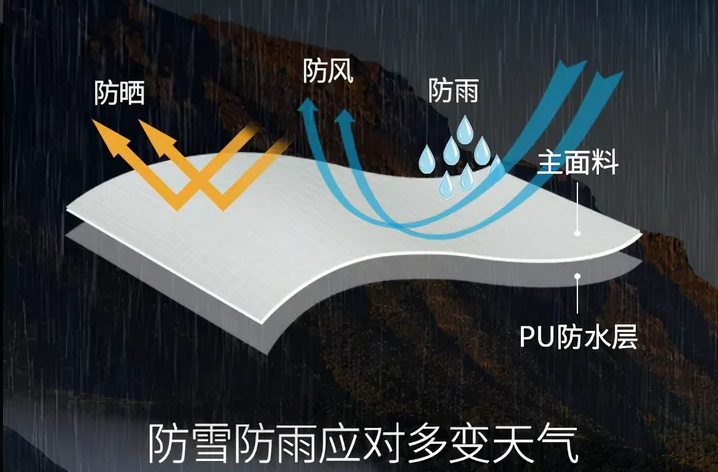
- It can also be distinguished by tent type, such as:
The waterproof index of family camping tent should be above 2000MM;
The waterproof index of alpine tents is above 5000 mm.
Windproof of tents
This is second only to waterproofing, and wind resistance is determined by shape, weight, and structural strength. The design strength of the tent poles is critical to withstand high winds. In addition, the diameter of the pole, the number of pole intersections, the mechanism for hanging the outer tent, the mechanism for connecting the outer tent to the pole, the overall structural quality, and the number and quality of the wind rope hanging points all need to be considered. These traits are evident when dealing with severe weather. It should also be noted that the wind rope hanging point on the side wall of the outer tent is often the most fragile on the tent.
If you often go camping, tents generally need to block heavy rain and short-term rainstorm. After the wind direction, ground nails and wind ropes are well laid, they need to resist Grade 6 or 7 winds, preferably Grade 8 winds or above.
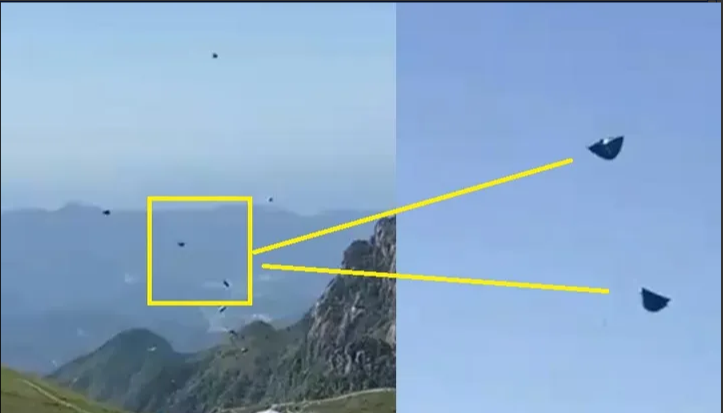
Ventilation of tents
The ventilation of the tent is related to the number of tent doors, especially when the weather is hot, the outdoor night is not necessarily very cool, if the ventilation of the tent is very poor, it will be very hot inside, so there must be an insect-proof mesh inner layer.
Some tents for hiking sacrifice comfort, such as fish ridge tents, generally single door, ventilation is relatively poor.
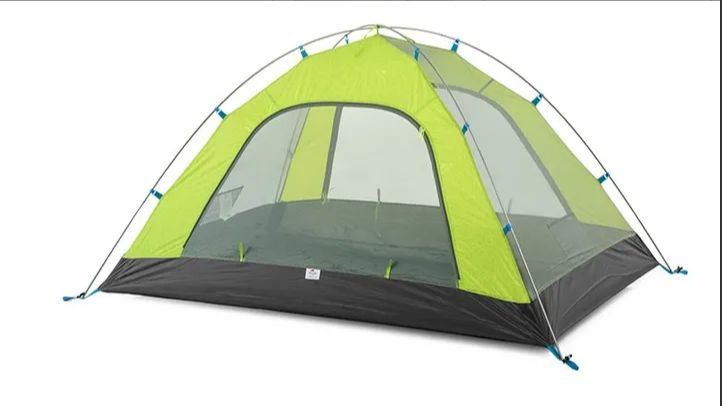
Tent fabric
Tent fabrics are generally divided into: polyester cloth, nylon cloth, Oxford cloth; Generally, nylon fabrics are more durable than polyester fabrics, and silicone-coated fabrics are stronger and more durable than PU fabrics.- Polyester cloth, with good elasticity and strength, bright color, smooth feel, heat resistance, light resistance is better, not easy to mold, moth, moisture absorption and other advantages, low temperature environment will not harden, but this fabric is widely used in low-cost tents.
- Nylon cloth, light texture, good air permeability, not easy to mold, nylon cloth by coating PU layer to achieve waterproof performance, the greater the value of the better rain resistance, PU coating in mm units, the current waterproof index is usually more than 1500mm, below this value do not consider.
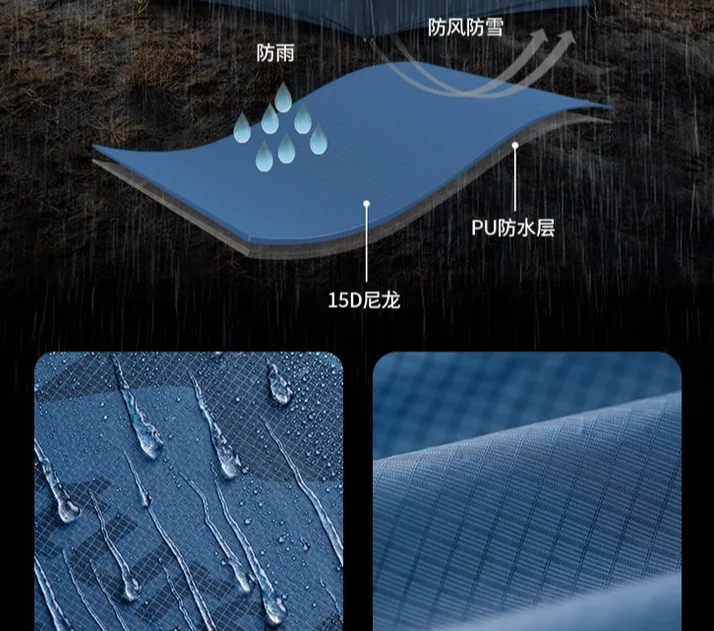
- Oxford cloth, primary color fabric, soft feel, light texture, generally used for tent bottom, add PU coating, has good waterproof, easy to wash and dry, durability and moisture absorption are better.
- In order to increase the waterproof characteristics of tents, silicone oil will be coated on the outside of tents. Some products will be coated with silicone on both sides, which is waterproof but more likely to catch fire. Especially in winter, because to warm the tent will burn firewood stove, kerosene stove, gas stove, double-sided silicone oil tent safety is worse. Of course, choosing a good stove can also effectively reduce the risk of fire.
Structure and quality of tents
No matter what kind of tent, it is roughly composed of three parts: Tent poles, tarpaulins, ground nails & wind ropes. Therefore, the quality of tents is mainly based on these large pieces.
Tent pole: As the main support structure of the tent, just like the skeleton of the car body, it is the key component of the whole tent mechanics. The body should be made of high-strength steel to maintain the strength of the body. If the tent wants to stand upright, the strength of the tent pole should not be low. At present, most of the tent poles are made of aluminum alloy, which has good wind resistance and is less affected by temperature. PS: Some tents will use glass fiber material tent poles, but we do not recommend it very much, because the temperature resistance of fiber materials is not ideal, and it is easy to break in cold areas.
Tarpaulin: It is the enclosure structure of the tent. Like the skin of the car body, it is all that protects the wind and rain. Most tarpaulin materials are polyester & nylon. The two materials have their own characteristics, polyester fiber corrosion resistance, good air permeability, nylon material is more wear-resistant. If the use environment is relatively harsh, nylon material is preferred.
Ground nails & wind ropes: can provide auxiliary fixing effect for tents to ensure the stability of tents. It holds the tent inside the camp by ropes. Generally speaking, the more nails fixed, the stronger the tent. At present, most tents need about 6-12 ground nails & wind ropes to fix them. In general, about 40cm of ground nails are enough to make a single tent stand in bad weather, and the best angle of ground nails is 45-60 degrees.
Those things about the roof tent
- What is a roof tent roof tent is installed in the roof of the tent, there are soft shell and hard shell points, roof tents generally weigh about 50kg, so once installed on the roof, nothing to remove it is not so easy.
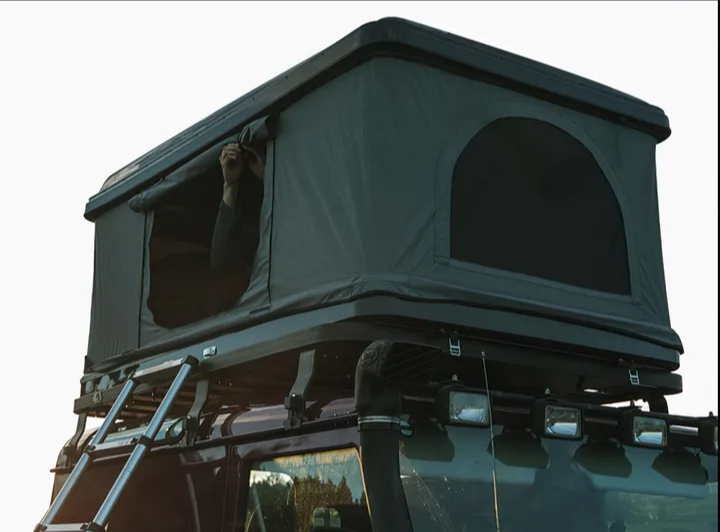
- The advantages of roof tents
The roof tent is equivalent to fixing the tent on the roof, which is very convenient to use. In addition, the roof tent has a certain distance from the ground, which is safer in the wild, and the moisture-proof effect is much better than that of the ground tent. When driving by yourself, if you encounter rainstorm weather halfway, then the roof tent has a great advantage. As long as the vehicle is parked well, you can sleep by pulling the roof tent. In addition to parking the car, you should also consider the ground for setting up the tent. Sometimes, there are only parking places without tent camp, which is very painful. Moreover, in the rainstorm, setting up the ground tent is a very painful thing.
- Disadvantages of roof tents
In addition, after installing the roof tent, there will be slight wind noise on the highway, and it will be relatively troublesome to clean it.
The most important point is that roof tents are more expensive than ordinary tents. Most of the roof tents on the market range from 5000 to 15000. Roof tents are really convenient, but they can only be used with vehicles, and once installed, they are not easy to disassemble.
So, how to choose, or depends on your own preferences. If you are a pure self-driving enthusiast, then I recommend buying.
Cleaning of tents
The tent will generally be dirty for a period of time and needs to be cleaned, otherwise it will affect the waterproof property of the tent.
Tent cleaning can use laundry detergent, preferably with professional outdoor equipment cleaning agent to help restore the waterproof and breathable properties of the original fabric.
When the stain is thoroughly cleaned, you will also need to replace it with clean water and give the tent a final rinse. Next, hang it in the bathroom or on a clothesline to dry.
Here to remind you, do not put the tent in the sun exposure, direct ultraviolet rays will cause some damage to the tent fabric just washed.
